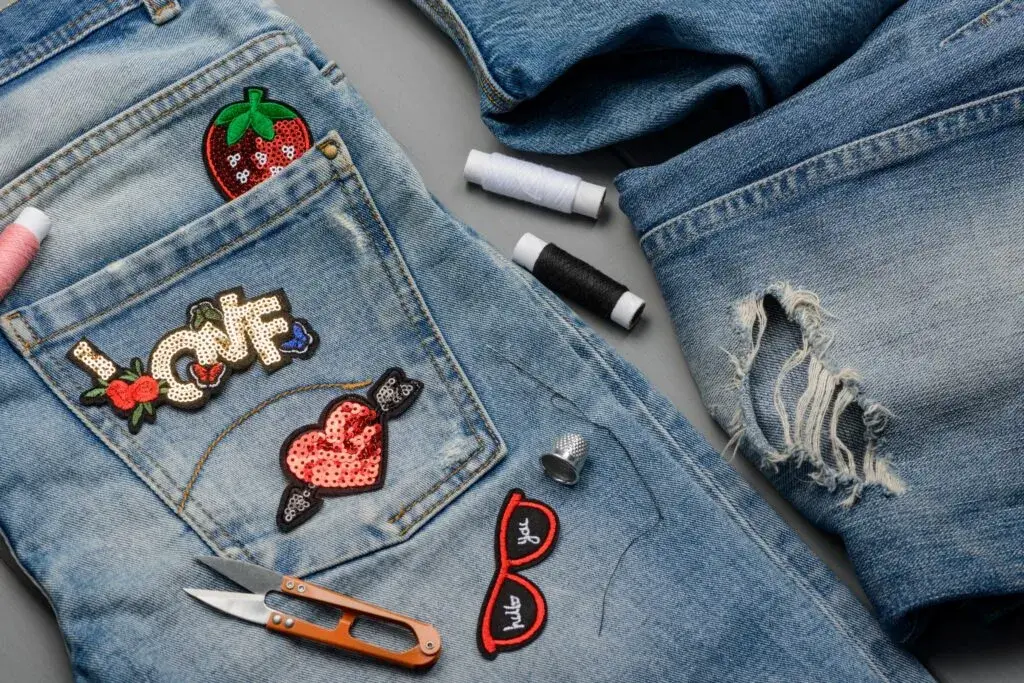How To Prevent Iron-On Patches From Falling Off
Iron-on patches are a great way to proudly display awards, badges, and emblems for clubs and societies. Not only do they cover up worn or frayed areas, but they’re also quick and convenient to apply—no sewing required!
That said, proper application is key. If not applied correctly, the patch could lift or peel off, spoiling your efforts. In this article, we’ll guide you on how to ensure your iron-on patch stays securely in place.
Choosing the Right Iron-On Patches
The world of iron-on patches is exciting, but with so many options, choosing the right one can be confusing! Don't worry, we've got you covered. Here at TheStudio.com, we want to ensure your patch stays put for years to come, so let's explore some key things to consider:
Patch Backings:
There are two main types of iron-on patch backings:- Adhesive Backing: These patches are the easiest to use, with the adhesive already applied to the underside. They're perfect for beginners and quick fixes.
- Fusible Web Backing: This type utilizes a heat-activated adhesive sheet called fusible web. You'll place the fusible web between the patch and fabric, then iron it all together. This method offers a stronger bond, ideal for heavier fabrics or patches that will see frequent use.
- Embroidered Patches: These patches are ready to iron on. The adhesive is already on the back, so simply place it on your fabric and follow the ironing instructions.
- Transfer Paper Patches: These patches require a bit more preparation. The image is printed on the adhesive side of the paper. Place the paper face-down on your fabric, iron it on, and then peel off the paper backing to reveal your patch.
Embroidered vs. Transfer Paper Patches:
Pro Tip: Need fusible web or a variety of iron-on patches for your project? Look no further! TheStudio.com offers a wide selection of high-quality options.
The Importance of Using High-Quality Patches
When it comes to customizing your gear, high-quality patches from brands like THE/STUDIO make all the difference. They’re vibrant, with crisp colors and clear designs, and most importantly, they adhere firmly to fabrics—so you don’t have to worry about them peeling or falling off.
On the other hand, cheaper patches tend to fade quickly, lack vibrancy, and may fray over time, compromising both their look and durability.
How to Choose Patches with Strong Adhesive Backing
To ensure your patch stays in place, follow these tips when selecting your patches:
- Go with a trusted brand: Opt for patches from reputable brands known for their quality and durability. These brands often use high-quality materials and advanced adhesive technologies to ensure a long-lasting bond.
- Check the Adhesive side: A shiny, smooth adhesive is a good indicator of a strong bond. Avoid patches with a dull or uneven adhesive, as this may compromise the strength of the bond.
- Avoid self-stick patches: Choose patches that require heat activation (like iron-on patches) over self-adhesive options. Heat-activated patches offer a more secure and long-lasting bond, especially for fabrics that may experience frequent washing or wear and tear.
Preparing the Surface for Application
- Clean the Surface: Before applying your patch, gently clean the garment using a soft brush or sponge. Remove any dirt, lint, or residue that could interfere with the adhesive. Make sure the fabric is completely dry before proceeding. If you’re using fusible web, it’s especially important to wash the fabric beforehand to ensure the adhesive bonds properly.
- Smooth Out Wrinkles: A smooth surface is essential for a strong bond. Iron out any wrinkles or creases in the fabric to create a flat and even surface for the patch. You can use an ironing board or a flat, heat-resistant surface like a kitchen counter or table. To protect your fabric, place a pressing cloth between the iron and the fabric.
Apply the Patch
- Heat and Pressure: Set your iron to the highest heat setting without steam. First, iron the garment flat to remove any wrinkles. Then, place the patch in your desired location and cover it with a thin, clean cloth. Apply firm, even pressure with the iron for about 15 seconds. To ensure a strong bond, continue applying heat and pressure for an additional 2-3 minutes.
- Iron the Back: Flip the garment inside out and iron the back of the patch area for another 2-3 minutes. This will help the adhesive bond securely from both sides.
- Cool Down and Check: Let the patch cool completely before handling. Once cool, check the edges of the patch to ensure they are securely attached. If any edges are lifting, apply a bit more heat for 10-15 seconds.
- Remove the Paper Backing: For paper-backed patches, wait until the patch is completely cool before gently peeling off the paper backing.
By following these steps, you can ensure a long-lasting and professional-looking patch application.
Maintaining Your Custom Patch
Why Do Patches Fall Off?
- Poor application on an uneven surface
- Inadequate heat and pressure during application
- Frequent washing
- Exposure to extreme temperatures
How to Prevent Patches from Falling Off
- Stitch around the edges: Adding small stitches around the custom patch can provide extra security. Just a few stitches in matching thread will keep your patch intact.
- Wash with care: Avoid washing too frequently and choose a cool or lukewarm wash. When using a washing machine, opt for the Delicates cycle.
- Turn garments inside out: Always turn the garment inside out before washing, and never use direct heat to dry. Air dry to preserve the patch.

Final Thoughts
For durable, long-lasting patches that make a bold statement THE/STUDIO offers high-quality patches that are built to last. With proper care and maintenance, your custom patches will stay secure and vibrant for years to come.
Frequently Asked Questions
1. What’s the Best Way to Apply Iron-on Patches?
To ensure your iron-on patch adheres securely, follow the manufacturer's specific instructions. Use a clean, flat surface and apply even heat and pressure with a hot iron. Let the patch cool completely before handling to allow the adhesive to set properly. For added protection, consider using a pressing cloth between the iron and the patch. By following these simple steps, you can enjoy a long-lasting and stylish addition to your garment or accessory.
2. Can I Use a Hair Dryer Instead of an Iron to Apply the Patch?
A hairdryer is great for quick drying, but it doesn't provide the consistent pressure needed to make your patch stick securely. A little-known secret is that hair straighteners can be a lifesaver when it comes to sealing your patch! The even pressure from the straightener's plates helps to create a strong bond between the patch and your fabric. Just be patient, as it might take a bit longer to cover the entire patch with a smaller straightening plate.
3. What Can I Do if My Patch Starts to Peel Off?
If your patch starts to peel, don't worry! You can try to reattach it by gently ironing it again, just like you did the first time. If that doesn't work, you can sew a few small stitches around the edges to secure it.
For patches that are really loose, you might need to remove them completely and use fabric glue to reattach them. This is totally normal after a few years of wear and tear.
4. Are There Any Special Instructions for Applying Patches To Certain Fabrics?
Choosing the Right Fabric for Your Patch: When picking a spot for your patch, it's best to choose a fabric that's similar in weight to the patch itself. Cotton and denim are great options for iron-on patches.
Watch Out for Heat-Sensitive Fabrics: Before you start ironing, check the care label of your garment. If you see an iron with a red cross through it, it means the fabric is heat-sensitive and might not be the best choice for an iron-on patch.
Avoid Delicate Fabrics: Polyester, silk, and other delicate fabrics can be easily damaged by the heat of an iron. It's best to choose a more durable fabric for your patch.
5. Can I Use Iron-on Patches on Leather or Other Non-fabric Materials?
Leather jackets are timeless fashion staples. Adding a personalized patch can elevate your style. However, traditional iron-on patches aren't suitable for leather. The high heat can damage the leather and the adhesive might not bond properly.
So, how can you add a patch to your leather jacket?
- Sewing It On: This is the most durable method. You can sew the patch onto the leather yourself or have a tailor do it for you.
- Using Leather-Safe Adhesive: A strong, leather-safe adhesive can be used to attach the patch. Make sure to follow the adhesive's instructions carefully.
What About Other Fabrics?
Cool Down and Check: Let the patch cool completely before handling. Once cool, gently check the edges of the patch to ensure they are securely attached. If any edges are lifting, apply a bit more heat for 10-15 seconds, but be careful not to over-heat the fabric.
For paper-backed patches, wait until the patch is completely cool before gently peeling off the paper backing. If the paper is stubborn, you can gently lift a corner and slowly peel it away.




